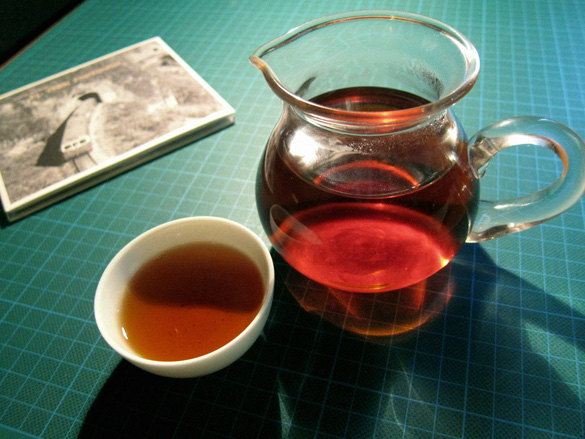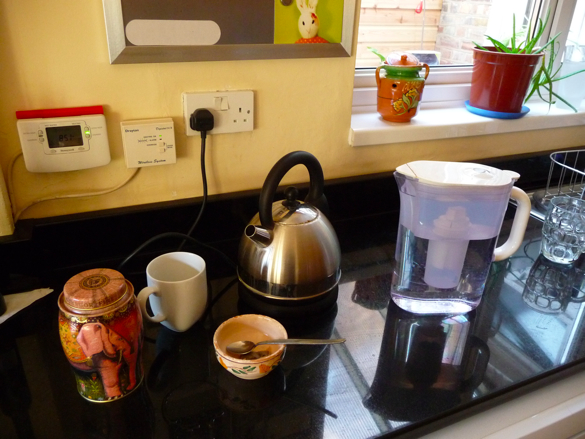Strong Ale
8 lbs. Hugh Baird brand English Pale malt
1 1/3 lbs. Baird) Pale malt, roasted.
For darker ale, roast to amber: 30 mins. at 225 F. followed by 30 mins. at 300 F. For lighter, roast an hour at 225 F.
around 3 lbs. rolled oats
14 to 16 qts. water (main batch)
14 will produce 1 1/2 gallons of ale; 16 will produce 2 gallons
6 to 8 qts. water (second runnings)
1 pkt, Danstar brand Nottingham ale yeast
1 pkt, Danstar brand Windsor ale yeast
Pre-heat the oven to 225 degrees F. Measure out 1 1/3 lbs. of pale malt, and place it in an e.g. 9 x 13 inch baking pan. When the oven is hot, place the malt in the oven and bake for 30 mins. Then increase the heat and bake another 30 mins. Or, for a lighter colored ale, simply bake 60 mins. at 225 F. Remove and set out to cool.
Sanitize an insulated tun and two fermentation vessels (two 3-gal. food-grade plastic buckets with lids).
Boil water for first runnings (14 to 16 qts.). Crush the malt, mixing the amber (baked) malt with the pale malt. Then mix the oats with the crushed malt well.
If your tun has a false bottom or other similar device, pour in enough boiling water to cover it. Then pour in all of the grain. Finally, slowly ladle the remaining water over the grain, pouring from some height.
Cover the mash tun and let sit 30 mins. Open and stir well, then close and let sit another 3 1/2 to 4 hours. This is a hot mash, so it will need this long period of time to mash (convert the starches into sugars).
Put the water for the second running on to boil. Set up the first fermentation vessel under the drain valve or tube of the insulated tun, and slowly run the liquor from the first mash into the first vessel. Close and set aside to cool.
After the first liquor has been drained out, and when the water for the second running has reached a boil, pour it into the damp grain. Allow to sit for 30 mins, then set up the second fermentation vessel and run this liquor into it. Close the second fermenter, and allow both to cool overnight.
In the morning, sanitize a smaller pan or ladle, a Pyrex measuring cup, and a spoon. Also boil about a cup of water and cool it, covered. Rehydrate the packets of yeast into 3/4 cup of the boiled water. Pour this yeast mixture into the two fermenters, 2/3 into the strong main batch, 1/3 into the second runnings. Use the sanitized ladle to aerate each of the batches (by picking up liquor and pouring it back in turbulently).
Close the fermenters (filling the water locks, if any) and allow to ferment.
Weak Ale
For 2 1/2 gallons of ale:
Ingredients:
4 2/3 lbs. Hugh Baird brand English Pale malt
1 1/2 lbs. rolled oats
13 qts water
1 pkt Danstar brand Nottingham ale yeast
1 pkt Danstar brand Windsor ale yeast
1/4 oz. Light Oak chips
Boil water. Crush the malt, then mix it well, while still dry, with the oats.
Open up the insulated tun and place it on the floor near the stove (where the boiling water is). Pour 2 quarts of water into the tun from a reasonable height, moderately slowly.
Pour all the dry grain into the lauter tun.
Slowly pour 3 more quarts of boiling water over the grain. Don’t stir. Put the cover on the tun and let it stand for 10 mins. Then add 1 more quart of boiling water. At this point, there should be a very small amount of visible liquid. Put the lid back on and wait 20 more mins.
Now take the lid off and stir it all up. It should be about the consistency of fairly thick porridge. Put the lid back on and do something else for a while – at least an hour and a half. (I went out for a beer with some friends for 3 1/2 hours.)
Open up the tun and stir in 3 more quarts of boiling water, and stir. Close up again and wait 25 more mins.
Finally, add remaining boiling water (4 quarts)
Stir well.
Set up the sanitized fermenter. Open the mash tun valve (or otherwise start straining out the wort, that is the liquid part, from the grain. (Unlike modern methods, I did not recirculate the liquid in any way.) The first gallon should go quickly; straining the last gallon should be done somewhat more slowly in order to get most of the liquid out.
Close the fermenter and let the wort cool overnight.
Rehydrate both packages of yeast according to the package instructions (being careful to use water that has been boiled and cooled, and a glass that has been sanitized in some way). Pitch the yeast into the wort, and shake, stir, and otherwise agitate the wort in order to aerate it.
Let the ale ferment for a day; the yeast should have started, and activity should be well under way. Boil the oak chips in approx. 1 cup water. When the water is the color of a cup of tea, take off heat and allow to cool some. Pour off water, then add approx. 1/2 cup of water back into chips. Raise this to a boil again, then allow to cool; it should be just barely darker in color than normal water. Add this oak-water to the wort.
Let the ale ferment for a couple more days. Draw off and serve.








